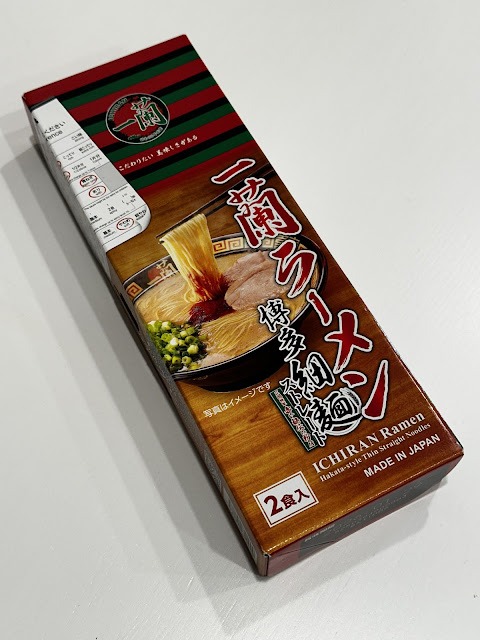Nongshim K-Army Stew Instant Ramen Review
I'm going to start this review off with a WOW! This particular Nongshim USA instant noodle packet has really impressed me with the packaging, the contents, and the flavour. If you've read enough of my reviews you know I'm not a big fan of super spicy as I want flavour not just heat, but I have found two kinds of Nongshim Korean instant ramen that I like. The first one is Ansungtangmyun or Ansung Miso Ramen (mild spice) and the second is this Nongshim K-Army Stew I'm reviewing now. I've tried the K-Army twice now and my second impression was just as tasty as the first.
Versions of this instant ramen were available in Korea long ago and imported to Canada / USA, but I think Nongshim USA has been manufacturing this for one or two years now. It is interesting to note that every one of the major Korean noodle makers: Ottogi, Nongshim, Paldo and Samyang have their own versions of this very popular dish.
 |
| K-Army and a bowl of steaming hot noodles with wieners and green onions. |
So what exactly is K-Army Stew? It is a version of Budae Jjigae or Korean army stew (부대찌개). It is a popular hot pot dish in Korea that has its roots in the aftermath of the Korean War in the 1950s when there was a shortage of food. Budae Jjigae combined Korean and American foods into a new fusion of flavours and ingredients. This stew is a mashup of Korean gochujang (red chili paste), kimchi (fermented cabbage) and processed American foods hot dogs, SPAM, and baked beans. These kinds of American foods were scrounged or smuggled from the US bases and provided tasty protein. There is an interesting article about this stew at the BBC here.
"It is said that budae-jjigae begun as a buttery stir-fried snack made of sausages, ham, cabbages and onions to accompany makgeolli (rice wine), but later on, anchovy broth flavored with gochujang and kimchi was added to create the stew that is enjoyed today. The stew was also referred to as Jonseun-tang (존슨탕; "Johnson soup"), Johnson being the U. S. President Lyndon B. Johnson, who is said to have raved about the taste of the dish amid his visit to Korea." Wikipedia.
 |
| The green packaging is your first impression of K-ARMY and it creates a good one with a kind of poppy military image. |
The front of the noodle package has a digital camouflage green pattern for the background. There is a great big K ARMY text announcing the product name with the Korean yin/yang symbol from their national flag to make it obviously Korean. The background to the K ARMY text is a green helmet and underneath it is a big delicious picture of a savoury, spicy stew with noodles in an army mess tin. There is some grass designs at the bottom to let you know you are hugging the ground! I kind of like the fact it also says "with Chili beans."
 |
| The back of the noodle package with cooking instructions for microwave and the ingredients. This is a product for Canada so there is English and French. |
So far, the design of the package and the ingredients are first rate! So all that is left is to prepare the noodle soup and see if the flavour is also great. When you first open the soup base packet you can smell the chili peppers and a savoury note to the spice mix. The preparation for this noodle soup has you boiling 500 mL of water. When the water is boiled you add in the soup base and the dried ingredients. The noodle block goes in right afterwards. The noodles start to soften after a minute or two and you can stir them to break up the block for more even rehydration (the noodles are cooked already by frying). I had some cut up wieners handy and sliced green onions, and threw these in after the noodle block was broken up. The smell that came off the soup was very spicy and fragrant with a chili pepper smell and a deeper note that kind of reminded me of an American chili. It smelled great and I keep thinking there was a paprika note or something to it too. Anyhow, it smelled really good.
After pouring the soup into a bowl it was time to taste test. I've already said the soup smelled great, so I sure hoped the soup tasted as good. The soup was thicker in consistency and had a nice rich spicy flavour that was a low-medium heat. The savoury heat of the soup comes from aged kimchi for the hearty flavour and there is a hint of tartness to it that I only noticed when I just sipped the broth.
The noodles were thick and chewy - like a Nongshim noodle, and were good. There is supposed to be 40% potato starch in the noodles according their website. Combined with the meatiness of the wieners and the extra green onions, this was a super tasty soup. Finding the kimchi cabbage, fish cakes, and pinto beans in a bite of noodles was good too! I've never had the opportunity to try an authentic Budae Jjigae, but I do like this instant ramen a great deal.
 |
| K ARMY Stew with weiners and extra green onions. |
Follow me on Twitter a @Tostzilla or my feedburner.
More snacks and Japanese pop culture.














Comments
Post a Comment